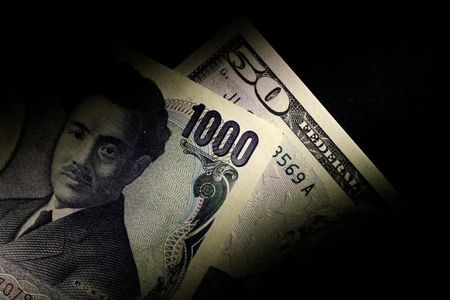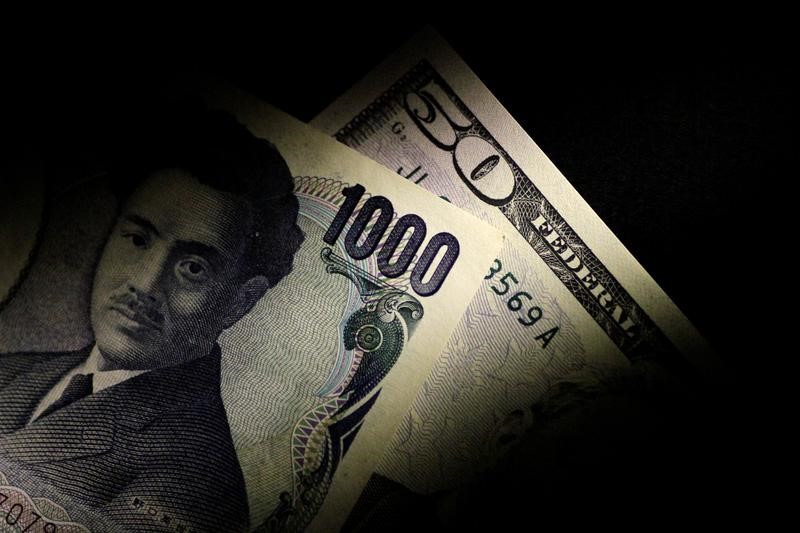Forex
Dollar slips from strength; yen gains after Ueda’s comments


© Reuters.
Investing.com – The U.S. dollar slipped lower in early European trade Tuesday, while the Japanese yen appreciated in the wake of the latest Bank of Japan policy meeting.
At 04:20 ET (09:20 GMT), the Dollar Index, which tracks the greenback against a basket of six other currencies, traded 0.1% lower at 102.997, handing back some of the almost 2% gains it has seen since the start of this year.
Dollar drifts lower ahead of key data
The greenback has drifted lower Tuesday, but remained close to one-month highs as traders price in a greater chance that the central bank will keep rates steady in March, a marked reversal from earlier expectations for a cut.
The is widely expected to keep rates on hold when it meets next week, and ahead of this investors will have some key U.S. economic readings to digest.
Fourth-quarter data, on Thursday, is expected to show some cooling in growth, while data, the Fed’s preferred inflation gauge, is likely on Friday to reiterate that inflation remained sticky in December.
Yen appreciates after Ueda speaks
In Asia, fell 0.5% to 147.39, after the maintained its ultra-low interest rates and stuck to its ultra-dovish policies, as widely expected.
The central bank also forecast lower inflation in fiscal 2024, providing less impetus to immediately begin tightening its ultra-loose policy.
However, BOJ Governor indicated in his post-decision comments that the time for tightening policy was drawing nearer.
“Our core-core inflation forecast is at 1.9%, very close to our 2% target,” he said. This was the case in October but it happened again this time, after close scrutiny. This is the biggest factor that made us more convinced than before that the likelihood (of sustainably achieving our price target) is gradually heightening.”
traded 0.3% lower to 7.1712, with the yuan helped by recent reports that the People’s Bank of China was selling dollars in open markets to support the Chinese currency.
Investors look to Lagarde for guidance
In Europe, traded 0.1% higher at 1.0886, ahead of the European Central Bank’s policy-setting meeting on Thursday.
The is certain to keep rates steady, and thus investors will focus on the tone of the policy statement and President ‘s press conference.
“We don’t expect this meeting to be a turning point for eurozone rates or for the euro,” said analysts at ING, in a note.
“We are, indeed, in a phase of data dependency. Expect President Lagarde to reiterate it.”
traded 0.2% higher at 1.2724, with sterling helped by the release of data showing U.K. fell to £7.8 billion last month, around half the sum borrowed a year earlier and the lowest figure for a December since 2019.
This will be a boost to Chancellor Jeremy Hunt as he prepares to unveil the Budget in March as a general election looms.

 Forex3 years ago
Forex3 years agoForex Today: the dollar is gaining strength amid gloomy sentiment at the start of the Fed’s week

 Forex3 years ago
Forex3 years agoUnbiased review of Pocket Option broker

 Forex3 years ago
Forex3 years agoDollar to pound sterling exchange rate today: Pound plummeted to its lowest since 1985

 Forex3 years ago
Forex3 years agoHow is the Australian dollar doing today?

 Cryptocurrency3 years ago
Cryptocurrency3 years agoWhat happened in the crypto market – current events today

 World3 years ago
World3 years agoWhy are modern video games an art form?

 Commodities3 years ago
Commodities3 years agoCopper continues to fall in price on expectations of lower demand in China

 Economy3 years ago
Economy3 years agoCrude oil tankers double in price due to EU anti-Russian sanctions





















